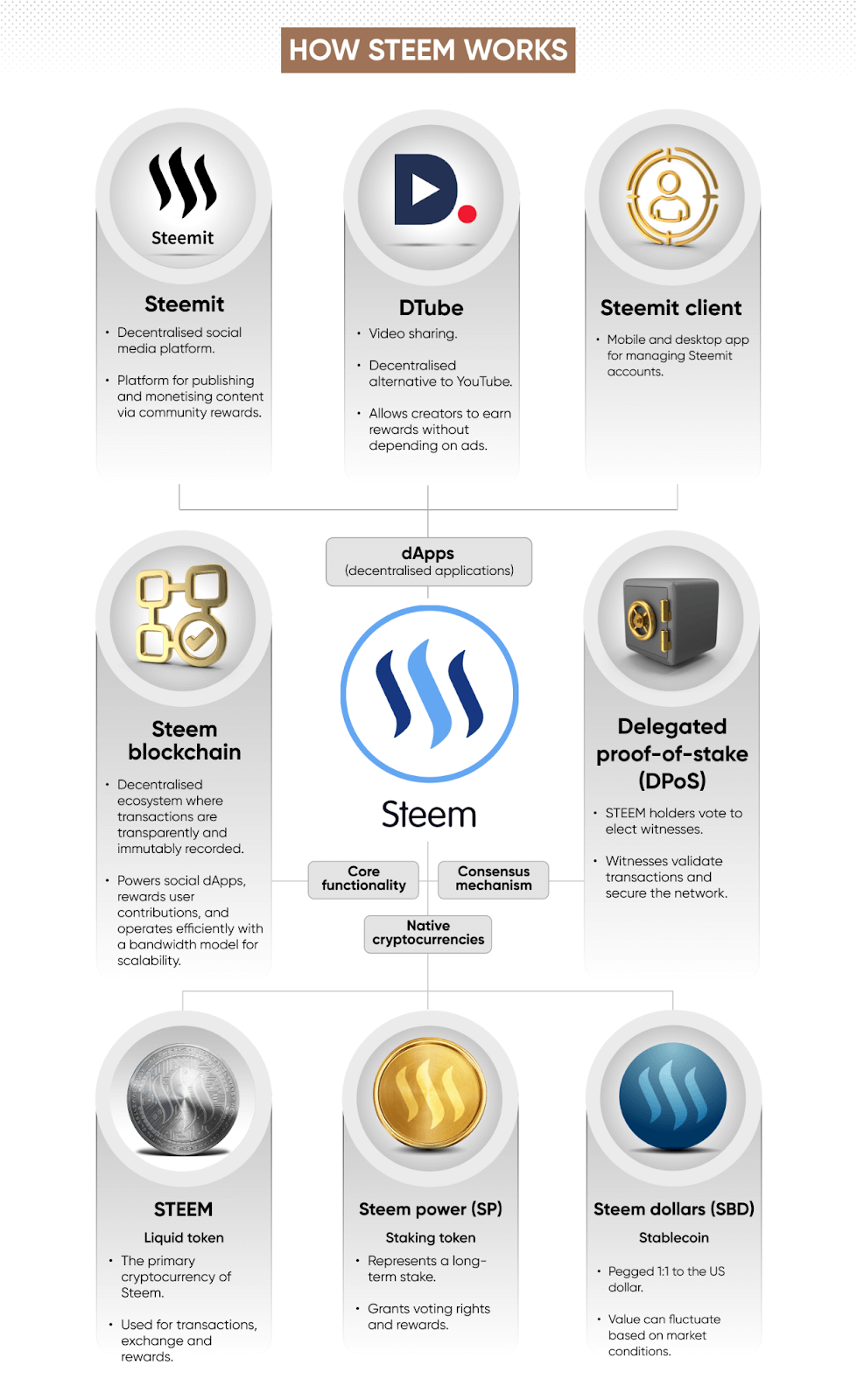What is Steem and how to trade it?

Learn all about Steem and the STEEM price history, how the blockchain and its cryptocurrency work, and how to trade STEEM/USD via CFDs.
Go to market page
What is Steem?
Steem is an open-source, decentralised blockchain launched in 2016 by Ned Scott and Dan Larimer, the latter known for co-founding BitShares and EOS. While Larimer departed soon after its inception, Steem remains the foundation for social platforms that reward content creation, curation, and community building, aiming to reduce censorship and reliance on advertisers.
Steem powers social dApps like Steemit, where users can publish and monetise content. Unlike traditional social media, where platforms retain most benefits, Steem’s reward system directly incentivises user engagement and value creation.
Its primary cryptocurrency, called STEEM, powers the ecosystem and its reward mechanisms while enabling fast transactions without direct monetary fees, using a bandwidth model. This provides scalability for social applications, unlike many other blockchains primarily focused on financial transactions.
Steem, Bitcoin, Ethereum & Tron: What are the differences?
Steem is frequently compared to well-known blockchains like Bitcoin, Ethereum, and Tron, yet it distinguishes itself with a unique focus and innovative technology.
Here’s how these blockchains and their tokens differ:
|
Steem |
Bitcoin |
Ethereum |
Tron |
|
|
Launch year |
2016 |
2009 |
2015 |
2018 |
|
Token |
STEEM |
|||
|
Primary goal |
Social content and community rewards |
Digital currency and store of value |
Smart contracts and dApps |
Digital media sharing and dApps |
|
Consensus mechanism |
Delegated proof-of-stake (DPoS) |
Proof-of-work (PoW) |
Proof-of-stake (PoS)* |
Delegated proof-of-stake (DPoS) |
|
Transactions per second (TPS) |
10,000** |
7** |
12–15** |
2,000** |
|
Transaction costs |
None |
Varies |
Varies |
None |
|
Max token supply |
Inflationary, adjusted annually to sustain network rewards |
21 million BTC |
Unlimited, deflationary* |
Unlimited, regular burn mechanisms |
*After the ‘Merge’.
**Approximate, depends on factors such as network congestion
Learn more about Bitcoin (BTC), Ethereum (ETH) and Tron (TRX) – read our comprehensive Bitcoin, Ethereum and Tron guides
How does Steem work?

Steem operates as a blockchain – a transparent, immutable public ledger where every transaction is securely recorded. Network participants validate these transactions, ensuring no single entity has the power to manipulate the system. This decentralised design enhances security and fosters trustless interactions, although its consensus mechanism prioritises efficiency over full decentralisation.
Steem is secured by a delegated proof-of-stake (DPoS) consensus mechanism that features a democratic model where STEEM token holders vote to elect a set of 'witnesses' to validate transactions and maintain the blockchain. While this system increases scalability and efficiency, it relies on a smaller, elected group, which may reduce decentralisation compared to systems like Bitcoin's proof-of-work.
Its ecosystem revolves around its native tokens – STEEM, STEEM Power (SP) and Steem Dollars (SBD) – each serving different purposes:
- STEEM: A liquid token for trading or converting into other cryptocurrencies.
- STEEM Power (SP): Represents a long-term stake in the network, granting voting influence, increased rewards for participation and determining the weight of votes for content rewards.
- Steem Dollars (SBD): A stablecoin designed to reflect the value of one US dollar but has experienced significant volatility.
Content creators and curators earn STEEM and SP based on the quality and popularity of their contributions, incentivising engagement and rewarding users for building the community.
Steem is also home to a suite of dApps which utilise the Steem blockchain’s capabilities to reward users, such as:
-
Steemit: The flagship social blogging platform where users can post, comment, and earn rewards.
-
Ecency (formerly Esteem): A mobile and desktop client for Steemit, offering functionalities like notifications, offline editing, and advanced analytics.
-
DTube: A decentralised video-sharing platform akin to YouTube but without ads, where creators earn rewards from multiple blockchain integrations.
- Splinterlands (formerly Steem Monsters): Originally a Steem-based blockchain card game, Splinterlands migrated to the Hive blockchain after the 2020 hard fork.
What’s the STEEM price history?
The STEEM price history has been marked by volatility since its launch in March 2016. Its first major price rise occurred in July 2016, coinciding with the public release of Steemit, a social media platform built on the Steem blockchain and its most prominent dApp. During this time, early adopters who created content during the test version of Steemit began to receive the first batch of rewards distributed by the platform.
This may have been a double-edged sword for STEEM, which saw prices fall significantly by the end of the year, possibly due to early-adopters and traders selling their holdings. As a result, STEEM prices moved within a well-defined range, trading for fractions of a dollar between November 2016 and April 2017.
As an altcoin, STEEM’s price movements often correlate with broader cryptocurrency market trends – particularly BTC and ETH. This is exemplified by STEEM’s price moving upwards during the 2017 cryptocurrency bull run, culminating in STEEM’s $8.57 all-time high on 3 January 2018. Subsequently, as the market entered a bearish phase, STEEM's price declined and fell below $1 by September 2018, and below $0.30 the following month.
Past performance is not a reliable indicator of future results
In 2019, STEEM struggled to regain its previous highs, maintaining an average price of around $0.15 throughout the year.
A hard fork in March 2020 was a significant event in STEEM’s price history, which divided the community leading to the launch of a concurrent blockchain called Hive. This contentious split led to a temporary price rise, followed by a decrease, underscoring how community governance decisions can significantly influence cryptocurrency valuations.
2021 brought price increases for STEEM, mirroring the broader crypto market’s bullish trend. Its price rise was partly due to growing interest in decentralised social media platforms and blockchain-driven content creation. But the euphoria was short-lived as the market entered a downturn in 2022.
The latter half of 2023 and early 2024 saw a modest recovery for STEEM. By January 2024, the price had climbed, showing signs of renewed interest in the Steem ecosystem. This uptick was supported by developments in the Steem blockchain, including updates to its consensus mechanism and the introduction of new dApps leveraging the platform's capabilities.
Which factors might influence the STEEM live price?
STEEM’s price can be affected by a range of influences, including those specific to the Steem blockchain, the cryptocurrency market and macroeconomic conditions. Here are some of the key factors that could move the STEEM price:
Network upgrades and technological developments
Enhancements to the Steem blockchain often have a direct impact on the STEEM price. For example, the 2020 introduction of ‘Communities’ – a feature that allowed users to create focused groups within Steemit – contributed to increased engagement, which helped influence the ecosystem’s activity. This uptick may have supported a modest price rally for STEEM as more users interacted with and utilised the platform.
However, not all developments are positive. In March 2020, controversy erupted over the Steem blockchain's governance, leading to a hard fork that created the Hive blockchain. This event caused short-term volatility in STEEM’s price as uncertainty loomed over the community’s future. Such examples highlight the importance of smooth technological advancements and stable governance.
Adoption and partnerships
Increased adoption through partnerships has proven to boost demand for STEEM. For instance, the popular blockchain-based card game Splinterlands was originally built on the Steem blockchain. Its success not only highlighted Steem’s capabilities but also brought new users into the ecosystem, driving demand for STEEM as players earned and traded tokens within the game.
On the flip side, the migration of successful projects like Splinterlands to the Hive blockchain highlights the challenges of retaining marquee dApps. This migration, combined with broader market conditions, coincided with a period of price stagnation for STEEM.
Regulatory developments
Regulatory news and events can have a profound impact on STEEM’s price. For example, discussions around potential SEC scrutiny of blockchain projects often ripple through the market, causing sudden shifts. Although STEEM has largely remained under the radar compared to larger cryptocurrencies like Bitcoin and Ethereum, regulatory developments could potentially shape its future prospects.
By contrast, a more favourable regulatory climate could open the door for greater adoption, as seen with other blockchain ecosystems that gained traction after achieving compliance or clarification from major financial authorities.
Cryptocurrency market trends
STEEM is not isolated from the broader crypto market. Its price has historically followed major market cycles. For example, during the 2021 bull market, STEEM saw a resurgence, with its price briefly surpassing $1 amid general market enthusiasm for cryptocurrencies, including decentralised social media platforms.
Similarly, STEEM's price was impacted during the market downturn of late 2022, as bearish sentiment across the crypto sector led to reduced trading volumes. These correlations highlight the importance of monitoring Bitcoin (BTC) and Ethereum (ETH) as bellwethers for STEEM’s price movements.
Community engagement and governance
Community-driven initiatives play a pivotal role in STEEM’s price dynamics. For example, new dApps have the potential to reinvigorate community participation, although clear correlations with price movements are often speculative. Strong community support has proven to be a stabilising factor for the ecosystem.
Conversely, divisive governance decisions – such as the 2020 Hive hard fork – have shown the potential to erode confidence, leading to sell-offs and price declines.
What are the STEEM trading hours?
STEEM operates on a decentralised blockchain network that is active 24 hours a day, seven days a week. This means you can trade STEEM at any time, including weekends and holidays.
-
Cryptocurrency exchanges – many exchanges facilitate 24/7 trading, allowing for continuous market participation.
-
Online trading platforms – some reliable and trusted brokerages provide STEEM trading via CFDs.
If you choose to trade CFDs, you can follow the STEEM performance live in US dollars with our comprehensive STEEM/USD price chart.
Alternatively, you can check out our STEEM/BTC price chart.
Monitoring the cryptocurrency’s activity can help you to keep an eye out for any key fundamental or technical events that may affect short-term movements in its value.
How to trade STEEM
STEEM is a cryptocurrency, meaning that it can be traded directly on a cryptocurrency exchange or through peer-to-peer transactions. Traders may also choose to trade STEEM via a derivative, a financial product that takes (or ‘derives’) its value from the price of the underlying asset.
You could use a contract for difference, or CFD, to trade on the price of STEEM pairs. A CFD is a contract, typically between a broker and a trader, where one party agrees to pay the other the difference in the value of a security, between the opening and closing of the trade.
You can use CFDs to trade on whether you think an STEEM pair will rise (called ‘going long’) or fall (‘going short’). CFDs give you access to leverage, allowing larger positions with a relatively small outlay. This amplifies your potential profits, but also your potential losses, making CFD trading risky.
You can learn more about trading cryptocurrencies with Capital.com in our comprehensive guide to cryptocurrency trading.
Aside from CFDs, you can also trade STEEM pairs through instruments like futures, options, ETFs, and mutual funds. Each offers an alternative to the leveraged trading of CFDs, suiting different risk profiles and strategies.
FAQs
What is Steem and who founded it?
Steem is a blockchain platform designed to reward users for content creation, curation, and community building. Launched in 2016, it was co-founded by Ned Scott and blockchain developer Dan Larimer, who also contributed to other blockchain projects such as EOS and BitShares (BTS) after his involvement with Steem. Steem was designed to decentralise the social media experience by enabling direct rewards without intermediaries, offering an innovative approach to online community interactions.
Is Steem a cryptocurrency?
Yes, Steem is a cryptocurrency ecosystem. Its primary token, STEEM, is used for transactions, rewards, and staking within the blockchain. The platform also includes Steem Power (SP) for long-term staking and governance influence and Steem Dollars (SBD), a stablecoin that aims to maintain a peg to the US dollar to provide price stability within the ecosystem. These three tokens work together to drive engagement and reward users for their contributions.
What is Steem used for?
Steem powers a vibrant ecosystem that caters to various user groups:
-
Content Creators and Social Users: Platforms like Steemit allow users to post, comment, and engage, earning rewards for their contributions.
-
Developers: Steem’s infrastructure supports the creation of decentralised applications (dApps) such as DTube and, historically, Splinterlands, which later migrated to the Hive blockchain.
-
Long-term traders and HODLers: The STEEM token offers utility and long-term growth potential..
-
Entrepreneurs: Steem enables monetisation without intermediaries, providing a foundation for creative projects.
This ecosystem fosters a unique network effect where developers, HODLers, and users collectively sustain and grow the platform.
Visit our other complete guides

How to trade Solana
